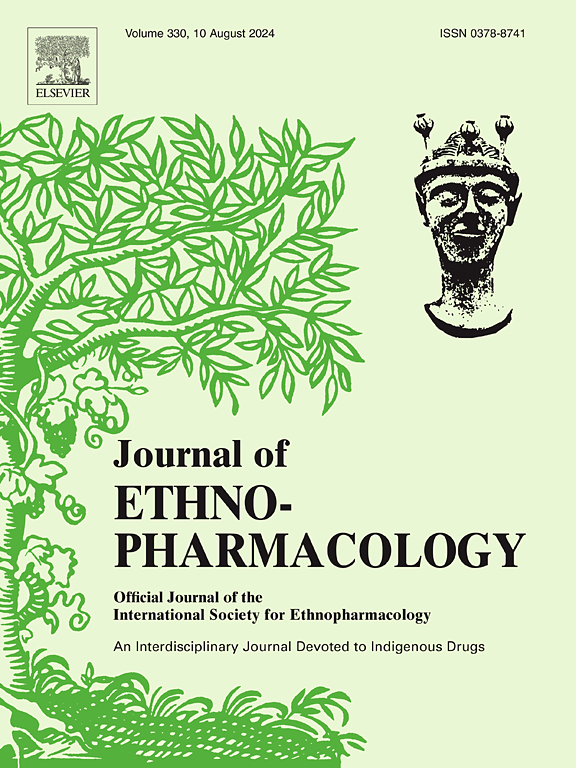Combining network pharmacology and transcriptomics to validate and explore the efficacy and mechanism of Huayu Wan in treating non-small cell lung cancer
IF 4.8
2区 医学
Q1 CHEMISTRY, MEDICINAL
引用次数: 0
Abstract
Ethnopharmacological relevance
Huayu Wan (HYW), a traditional Chinese medicine prescription widely used in the clinical treatment of advanced lung cancer, has been clinically proven to effectively inhibit the progression of pulmonary tumors and improve patients' quality of life. However, its specific components and potential anti-cancer molecular mechanisms remain unclear.
Aim of the study
To explore the active ingredients of HYW and predict its effective targets and pathways against non-small cell lung cancer (NSCLC) using a combination of network pharmacology and transcriptomics. These predictions were subsequently validated through in vitro and in vivo experiments, providing a theoretical basis for its anti-cancer mechanism.
Materials and methods
We first established a LEWIS tumor-bearing mouse model to evaluate the dose-response relationship and inhibitory effect of HYW in NSCLC. Using Ultra-High Performance Liquid Chromatography-Quadrupole-Orbitrap-High Resolution Mass Spectrometry (UHPLC-Q-Orbitrap-HRMS), we comprehensively explored the material basis of HYW's therapeutic effect on lung cancer. Combining network pharmacology and transcriptomics, we further verified the potential molecular targets and pathways of HYW. Finally, in vitro and in vivo molecular biological experiments were conducted to validate the predicted results.
Results
HYW exhibited a dose-dependent tumor inhibitory effect in the LEWIS tumor-bearing mouse model. Comprehensive qualitative analysis of the chemical components of HYW through UHPLC-Q-Orbitrap HRMS identified 39 major active ingredients, including geniposide, quercetin, taurine, and paeoniflorin. The constructed HYW active compound-NSCLC target network revealed 48 core targets, which may play a critical role in HYW's anti-NSCLC therapeutic effects. Combining transcriptomic data from mouse tumor tissues, four core targets—Pik3ca, Akt1, Pdk1, and VEGFA—were identified, along with the key signaling pathway PI3K/AKT/VEGFA. Immunofluorescence results indicated that HYW dose-dependently inhibited the positive expression of Ki67 in mouse tumor tissues. In vitro experiments showed that HYW significantly suppressed the proliferation, migration, and invasion abilities of H1299 and A549 cells. qRT-PCR and Western blot analyses demonstrated that HYW treatment downregulated the expression of Pik3ca, Akt1, Pdk1, and VEGFA, and inhibited the protein expression levels of p-PI3K/PI3K, p-AKT/AKT, and VEGFA.
Conclusion
HYW effectively inhibits the malignant proliferation of NSCLC cells. The mechanism of its anti-cancer effects is likely mediated by the suppression of the PI3K/AKT/VEGFA signaling pathway. This finding provides new molecular insights into the potential therapeutic application of HYW in the treatment of lung cancer.

结合网络药理学和转录组学验证并探讨化瘀丸治疗非小细胞肺癌的疗效及机制。
民族药理学相关性:化瘀丸是临床广泛应用于晚期肺癌治疗的中药方剂,经临床证实,化瘀丸能有效抑制肺部肿瘤的进展,提高患者的生活质量。然而,其具体成分和潜在的抗癌分子机制尚不清楚。研究目的:利用网络药理学和转录组学相结合的方法,探索白芍的有效成分,预测其抗非小细胞肺癌(NSCLC)的有效靶点和通路。这些预测随后通过体外和体内实验得到验证,为其抗癌机制提供了理论依据。材料与方法:我们首先建立LEWIS荷瘤小鼠模型,评价HYW在NSCLC中的量效关系及抑制作用。采用超高效液相色谱-四极杆-轨道谱-高分辨质谱(UHPLC-Q-Orbitrap-HRMS)技术,全面探讨白芍治疗肺癌的物质基础。结合网络药理学和转录组学,进一步验证了HYW潜在的分子靶点和通路。最后,通过体外和体内分子生物学实验对预测结果进行验证。结果:HYW在LEWIS荷瘤小鼠模型中表现出剂量依赖性的抑瘤作用。通过UHPLC-Q-Orbitrap HRMS对其化学成分进行综合定性分析,鉴定出栀子苷、槲皮素、牛磺酸、芍药苷等39种主要有效成分。构建的HYW活性化合物- nsclc靶点网络揭示了48个核心靶点,这些靶点可能在HYW抗nsclc治疗作用中发挥关键作用。结合小鼠肿瘤组织的转录组学数据,确定了四个核心靶点- pik3ca, Akt1, Pdk1和VEGFA,以及关键信号通路PI3K/AKT/VEGFA。免疫荧光结果显示,HYW对小鼠肿瘤组织中Ki67的阳性表达具有剂量依赖性抑制作用。体外实验表明,HYW能显著抑制H1299和A549细胞的增殖、迁移和侵袭能力。qRT-PCR和Western blot分析显示,HYW处理下调了Pik3ca、Akt1、Pdk1和VEGFA的表达,抑制了p-PI3K/PI3K、p-AKT/AKT和VEGFA的蛋白表达水平。结论:HYW能有效抑制非小细胞肺癌细胞的恶性增殖。其抗癌作用机制可能是通过抑制PI3K/AKT/VEGFA信号通路介导的。这一发现为HYW在肺癌治疗中的潜在应用提供了新的分子见解。
本文章由计算机程序翻译,如有差异,请以英文原文为准。
求助全文
约1分钟内获得全文
求助全文
来源期刊

Journal of ethnopharmacology
医学-全科医学与补充医学
CiteScore
10.30
自引率
5.60%
发文量
967
审稿时长
77 days
期刊介绍:
The Journal of Ethnopharmacology is dedicated to the exchange of information and understandings about people''s use of plants, fungi, animals, microorganisms and minerals and their biological and pharmacological effects based on the principles established through international conventions. Early people confronted with illness and disease, discovered a wealth of useful therapeutic agents in the plant and animal kingdoms. The empirical knowledge of these medicinal substances and their toxic potential was passed on by oral tradition and sometimes recorded in herbals and other texts on materia medica. Many valuable drugs of today (e.g., atropine, ephedrine, tubocurarine, digoxin, reserpine) came into use through the study of indigenous remedies. Chemists continue to use plant-derived drugs (e.g., morphine, taxol, physostigmine, quinidine, emetine) as prototypes in their attempts to develop more effective and less toxic medicinals.
 求助内容:
求助内容: 应助结果提醒方式:
应助结果提醒方式:


